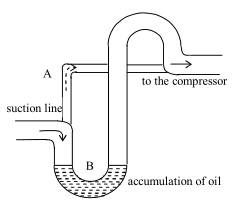After the shut-off valve of the starting air receiver has been opened, the air flows at full pressur...
through the filter to the main start valve “A” (with complicated construction), thereby applying pressure to
pipe between the main start valve “A” and the starting air control valve. Providing that maneuvering hand
wheel is in the "Stop" position, all other pipes are without pressure.
If the wheel is turned towards the “Start” position, a pawl above the starting air control valve is
actuated and the valve is opened, allowing air to flow to the main start valve “A”. It opens to allow a direct
through-flow of air. All cylinder starting valves are thus exposed to air pressure and, furthermore, air
flows to the starting air distributor, which is controlled by the camshaft. The distributor has a series of slide
valves arranged radially around the camshaft-one slide valve for each cylinder. These supply pilot air to the
cylinder starting valves with pistons in the “Start” position. The rotation of the engine crankshaft
commences, after which the cylinder starting valves are opened in the correct sequence. The crankshaft is
thus brought to speed of rotation necessary for compression and ignition.
When the maneuvering hand wheel is turned, the governor is actuated through a flexible cable setting
the fuel pumps. However, a fuel index limiting arrangement is inserted, which keeps the regulating shaft
and thus the fuel pumps at zero index during the starting process, ensuring that fuel is not injected into a
cylinder during the supply of starting air.
When the engine crankshaft has reached the necessary speed, the hand wheel is turned further past the
“Start” position with the result that the arm above the starting air control valve is released and the valve is
closed and vented. At the same time, the control piston in the main start valve “A” is also vented , thus
blocking the supply of air to the cylinder starting vales, the starting air distributor and the fuel index limiter.
Gradually, as the handle is turned further towards the maximum position. The governor increases the fuel
pump index and the crankshaft rotates more quickly. The governor ensures that the maximum permissible
speed is not exceeded.
(The following questions are based on the passage above)
参考解析:
1. This passage is about ________.
A. starting air system and speed regulating system
B. start of the engine
C. governor
D. crankshaft
2. If the shut-off valve of the starting air receiver is opened _______.
A. the cylinder starting valves are subject to pressure
B. the air flows to the starting air distributor
C. the starting air control valve is actuated
D. None of the above is true.
3. If the hand wheel is positioned "start"_______.
A. the starting air control valve will be opened
B. individual starting valve on each cylinder will be exposed to pressure
C. there will be cylinder starting valve or valves opened
D. All of the above are true.
4. During the supply of starting air to the cylinder _______.
A. air is consumed
B. fuel oil may be supplied to the cylinder or cylinders for reliable starting
C. the control piston in the main start valve “A” is vented
D. All of the above are true.


 百度扫一扫练题
百度扫一扫练题
 关注千题库公众号
关注千题库公众号








